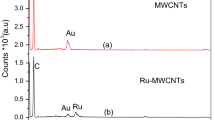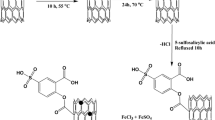Abstract
Adsorptive potential of maghemite decorated multiwalled carbon nanotubes (MWCNTs) for the removal of cadmium ions from aqueous solution was investigated. The magnetic nanoadsorbent was synthesized using a versatile and cost effective chemical route. Structural, magnetic and surface charge properties of the adsorbent were characterized using FTIR, XRD, TEM, VSM analysis and pHPZC determination. Batch adsorption experiments were performed under varied system parameters such as pH, contact time, initial cadmium concentration and temperature. Highest cadmium adsorption was obtained at pH 8.0 and contact time of 30 min. Adsorption behavior was kinetically studied using pseudo first-order, pseudo second-order, and Weber–Morris intra particle diffusion models among which data were mostly correlated to pseudo second-order model. Adsorbate-adsorbent interactions as a function of temperature was assessed by Langmuir, Freundlich, Dubinin–Radushkevich (D-R) and Temkin isotherm models from which Freundlich model had the highest consistency with the data. The adsorption capacity increased with increasing temperature and maximum Langmuir’s adsorption capacity was found to be 78.81 mg g−1 at 298 K. Thermodynamic parameters and activation energy value suggest that the process of cadmium removal was spontaneous and physical in nature, which lead to fast kinetics and high regeneration capability of the nanoadsorbent. Results of this work are of great significance for environmental applications of magnetic MWCNTs as promising adsorbent for heavy metals removal from aqueous solutions.
Graphical Abstract











Similar content being viewed by others
References
Abbas A, Al-Amer AM, Laoui T, Al-Marri MJ, Nasser MS, Khraisheh M, Atieh MA (2016) Heavy metal removal from aqueous solution by advanced carbon nanotubes: critical review of adsorption applications. Sep Purif Technol 157:141–161
Ali I, Gupta V (2006) Advances in water treatment by adsorption technology. Nat Protoc 1:2661–2667
Al-Khaldi FA et al (2015) Adsorptive removal of cadmium (II) ions from liquid phase using acid modified carbon-based adsorbents. J Mol Liq 204:255–263
Amin NK (2009) Removal of direct blue-106 dye from aqueous solution using new activated carbons developed from pomegranate peel: adsorption equilibrium and kinetics. J Hazard Mater 165:52–62
Andrade-Espinosa G, Muñoz-Sandoval E, Terrones M, Endo M, Terrones H, Rangel-Mendez JR (2009) Acid modified bamboo-type carbon nanotubes and cup-stacked-type carbon nanofibres as adsorbent materials: cadmium removal from aqueous solution. J Chem Technol Biotechnol 84:519–524
Avilés F, Cauich-Rodríguez J, Moo-Tah L, May-Pat A, Vargas-Coronado R (2009) Evaluation of mild acid oxidation treatments for MWCNT functionalization. Carbon 47:2970–2975
Bai L et al (2015) Surface modification of UF membranes with functionalized MWCNTs to control membrane fouling by NOM fractions. J Membr Sci 492:400–411
Baldi G, Bonacchi D, Innocenti C, Lorenzi G, Sangregorio C (2007) Cobalt ferrite nanoparticles: the control of the particle size and surface state and their effects on magnetic properties. J Magn Magn Mater 311:10–16
Barakat M (2011) New trends in removing heavy metals from industrial wastewater. Arab J Chem 4:361–377
Bayazit ŞS, Kerkez Ö (2014) Hexavalent chromium adsorption on superparamagnetic multi-wall carbon nanotubes and activated carbon composites. Chem Eng Res Des 92:2725–2733
Boparai HK, Joseph M, O’Carroll DM (2011) Kinetics and thermodynamics of cadmium ion removal by adsorption onto nano zerovalent iron particles. J Hazard Mater 186:458–465
Chen C, Hu J, Shao D, Li J, Wang X (2009) Adsorption behavior of multiwall carbon nanotube/iron oxide magnetic composites for Ni (II) and Sr (II). J Hazard Mater 164:923–928
Cho HH, Wepasnick K, Smith BA, Bangash FK, Fairbrother DH, Ball WP (2009) Sorption of aqueous Zn[II] and Cd[II] by multiwall carbon nanotubes: the relative roles of oxygen-containing functional groups and graphenic carbon. Langmuir 26:967–981
Correa-Duarte MA et al (2005) Alignment of carbon nanotubes under low magnetic fields through attachment of magnetic nanoparticles. J Phys Chem B 109:19060–19063
Da̧browski A, Hubicki Z, Podkościelny P, Robens E (2004) Selective removal of the heavy metal ions from waters and industrial wastewaters by ion-exchange method. Chemosphere 56:91–106
Dubinin M, Radushkevich L (1947) Equation of the characteristic curve of activated charcoal. Chem Central J 1:875–884
Foo K, Hameed B (2010) Insights into the modeling of adsorption isotherm systems. Chem Eng J 156:2–10
Freundlich H (1906) Over the adsorption in solution. J Phys Chem 57:385–470
Fu F, Wang Q (2011) Removal of heavy metal ions from wastewaters: a review. J Environ Manage 92:407–418
Gao Z, Bandosz TJ, Zhao Z, Han M, Liang C, Qiu J (2008) Investigation of the role of surface chemistry and accessibility of cadmium adsorption sites on open-surface carbonaceous materials. Langmuir 24:11701–11710
Gautam RK, Gautam PK, Banerjee S, Soni S, Singh SK, Chattopadhyaya MC (2015a) Removal of Ni (II) by magnetic nanoparticles. J Mol Liq 204:60–69
Gautam RK, Rawat V, Banerjee S, Sanroman MA, Soni S, Singh SK, Chattopadhyaya MC (2015b) Synthesis of bimetallic Fe–Zn nanoparticles and its application towards adsorptive removal of carcinogenic dye malachite green and Congo red in water. J Mol Liq 212:227–236
Girods P, Dufour A, Fierro V, Rogaume Y, Rogaume C, Zoulalian A, Celzard A (2009) Activated carbons prepared from wood particleboard wastes: characterisation and phenol adsorption capacities. J Hazard Mater 166:491–501
Godt J, Scheidig F, Grosse-Siestrup C, Esche V, Brandenburg P, Reich A, Groneberg DA (2006) The toxicity of cadmium and resulting hazards for human health. J Occup Med Toxicol 1:1–6
Gupta VK, Sharma S (2002) Removal of cadmium and zinc from aqueous solutions using red mud. Environ Sci Technol 36:3612–3617
Ho YS (1995) Absorption of heavy metals from waste streams by peat
Horsfall Jnr M, Spiff AI (2005) Effects of temperature on the sorption of Pb2+ and Cd2+ from aqueous solution by Caladium bicolor (Wild Cocoyam) biomass. Electron J Biotechnol 8:43–50
Hsieh SH, Horng JJ (2007) Adsorption behavior of heavy metal ions by carbon nanotubes grown on microsized Al2O3 particles. Int J Miner Metall Mater 14:77–84
Hu XJ et al (2014) Effects of background electrolytes and ionic strength on enrichment of Cd(II) ions with magnetic graphene oxide- supported sulfanilic acid. J Colloid Interface Sci 435:138–144
Huang ZN, Wang XL, Yang DS (2015) Adsorption of Cr(VI) in wastewater using magnetic multi-wall carbon nanotubes. Water Sci Eng 8:226–232
Huat BB, Gue SS, Ali FH (2004) Tropical residual soils engineering. CRC Press
Hutton M (1983) Sources of cadmium in the environment. Ecotoxicol Environ Saf 7:9–24
Kannan N, Sundaram MM (2001) Kinetics and mechanism of removal of methylene blue by adsorption on various carbons- a comparative study. Dye pigment 51:25–40
Khan AA, Singh R (1987) Adsorption thermodynamics of carbofuran on Sn (IV) arsenosilicate in H+, Na+ and Ca2+ forms. Colloid Surf 24:33–42
Köhler SJ, Cubillas P, Rodríguez-Blanco JD, Bauer C, Prieto M (2007) Removal of cadmium from wastewaters by aragonite shells and the influence of other divalent cations. Environ Sci Technol 41:112–118
Lagergren S (1898) About the theory of so-called adsorption of soluble substances. K Sven Vetenskapsakad Handl 24:1–39
Langmuir I (1916) The constitution and fundamental properties of solids and liquids. part I. Solids J Am Chem Soc 38:2221–2295
Lee KP, Arnot TC, Mattia D (2011) A review of reverse osmosis membrane materials for desalination—development to date and future potential. J Membr Sci 370:1–22
Li YH, Wang S, Luan Z, Ding J, Xu C, Wu D (2003) Adsorption of cadmium (II) from aqueous solution by surface oxidized carbon nanotubes. Carbon 41:1057–1062
Liang P, Liu Y, Guo L, Zeng J, Lu H (2004) Multiwalled carbon nanotubes as solid-phase extraction adsorbent for the preconcentration of trace metal ions and their determination by inductively coupled plasma atomic emission spectrometry. J Anal At Spectrom 19:1489–1492
Liang J et al (2015) Facile synthesis of alumina-decorated multi-walled carbon nanotubes for simultaneous adsorption of cadmium ion and trichloroethylene. Chem Eng J 273:101–110
Liu X, Wang M, Zhang S, Pan B (2013) Application potential of carbon nanotubes in water treatment: a review. J Environ Sci 25:1263–1280
Lu S, Chen L, Dong Y, Chen Y (2011) Adsorption of Eu(III) on iron oxide/multiwalled carbon nanotube magnetic composites. J Radioanal Nucl Chem 288:587–593
Lucas IT, Durand-Vidal S, Dubois E, Chevalet J, Turq P (2007) Surface charge density of maghemite nanoparticles: role of electrostatics in the proton exchange. J Phys Chem C 111:18568–18576
Luo C, Wei R, Guo D, Zhang S, Yan S (2013) Adsorption behavior of MnO2 functionalized multi-walled carbon nanotubes for the removal of cadmium from aqueous solutions. Chem Eng J 225:406–415
Mathialagan T, Viraraghavan T (2002) Adsorption of cadmium from aqueous solutions by perlite. J Hazard Mater 94:291–303
Misra DN (1969) Adsorption on heterogeneous surfaces: a dubinin-radushkevich equation. Surf Sci 18:367–372
Morales-Torres S, Silva TL, Pastrana-Martínez LM, Brandão AT, Figueiredo JL, Silva AM (2014) Modification of the surface chemistry of single-and multi-walled carbon nanotubes by HNO3 and H2SO4 hydrothermal oxidation for application in direct contact membrane distillation. PCCP 16:12237–12250
Nelke KH et al (2015) Occurrence and exposure to lead and cadmium and their environmental influence on eyesight. Polish J Environ Study 24:1491–1496
Organization WH (2004) Guidelines for drinking-water quality: recommendations vol 1. World Health Organization
Pashai Gatabi M, Milani Moghaddam H, Ghorbani M (2016) Point of zero charge of maghemite decorated multiwalled carbon nanotubes fabricated by chemical precipitation method. J Mol Liq 216:117–125
Pérez-Marín A, Zapata VM, Ortuno J, Aguilar M, Sáez J, Lloréns M (2007) Removal of cadmium from aqueous solutions by adsorption onto orange waste. J Hazard Mater 139:122–131
Purkayastha D, Mishra U, Biswas S (2014) A comprehensive review on Cd (II) removal from aqueous solution. J Water Process Eng 2:105–128
Qu X, Alvarez PJ, Li Q (2013) Applications of nanotechnology in water and wastewater treatment. Water Res 47:3931–3946
Rao MM, Ramesh A, Rao GPC, Seshaiah K (2006) Removal of copper and cadmium from the aqueous solutions by activated carbon derived from Ceiba pentandra hulls. J Hazard Mater 129:123–129
Ren X, Chen C, Nagatsu M, Wang X (2011) Carbon nanotubes as adsorbents in environmental pollution management: a review. Chem Eng J 170:395–410
Saeed A, Iqbal M, Höll WH (2009) Kinetics, equilibrium and mechanism of Cd2+ removal from aqueous solution by mungbean husk. J Hazard Mater 168:1467–1475
Sarkar B (2002) Heavy metals in the environment. CRC Press
Sasaki T et al (2013) Effective removal of cadmium from fish sauce using tannin. J Agric Food Chem 61:1184–1188
Shih YH, Li MS (2008) Adsorption of selected volatile organic vapors on multiwall carbon nanotubes. J Hazard Mater 154:21–28
Stobinski L, Lesiak B, Kövér L, Tóth J, Biniak S, Trykowski G, Judek J (2010) Multiwall carbon nanotubes purification and oxidation by nitric acid studied by the FTIR and electron spectroscopy methods. J Alloys Compd 501:77–84
Temkin M, Pyzhev V (1940) Kinetics of ammonia synthesis on promoted iron catalysts. Acta Physiochim URSS 12:217–222
Vuković GD, Marinković AD, Čolić M, Ristić MĐ, Aleksić R, Perić-Grujić AA, Uskoković PS (2010) Removal of cadmium from aqueous solutions by oxidized and ethylenediamine-functionalized multi-walled carbon nanotubes. Chem Eng J 157:238–248
Wang Q, Li J, Chen C, Ren X, Hu J, Wang X (2011) Removal of cobalt from aqueous solution by magnetic multiwalled carbon nanotube/iron oxide composites. Chem Eng J 174:126–133
Weber WJ, Morris JC (1963) Kinetics of adsorption on carbon from solution. J Sanitary Eng Divis 89:31–60
Xie M et al (2015) Synthesis and adsorption behavior of magnetic microspheres based on chitosan/organic rectorite for low-concentration heavy metal removal. J Alloys Compd 647:892–905
Yost K (1984) Cadmium, the environment and human health: an overview. Cell Mol Lif Sci 40:157–164
Zeng Y, Hao R, Xing B, Hou Y, Xu Z (2010) One-pot synthesis of Fe3O4 nanoprisms with controlled electrochemical properties. Chem Commun 46:3920–3922
Zhang H, Du N, Wu P, Chen B, Yang D (2008) Functionalization of carbon nanotubes with magnetic nanoparticles: general nonaqueous synthesis and magnetic properties. Nanotechnology 19:315604–315610
Zong P, Gou J (2014) Rapid and economical synthesis of magnetic multiwalled carbon nanotube/iron oxide composite and its application in preconcentration of U (VI). J Mol Liq 195:92–98
Author information
Authors and Affiliations
Corresponding author
Ethics declarations
Conflicts of interest
The authors have no conflicts of interest to declare.
Rights and permissions
About this article
Cite this article
Pashai Gatabi, M., Milani Moghaddam, H. & Ghorbani, M. Efficient removal of cadmium using magnetic multiwalled carbon nanotube nanoadsorbents: equilibrium, kinetic, and thermodynamic study. J Nanopart Res 18, 189 (2016). https://doi.org/10.1007/s11051-016-3487-x
Received:
Accepted:
Published:
DOI: https://doi.org/10.1007/s11051-016-3487-x




